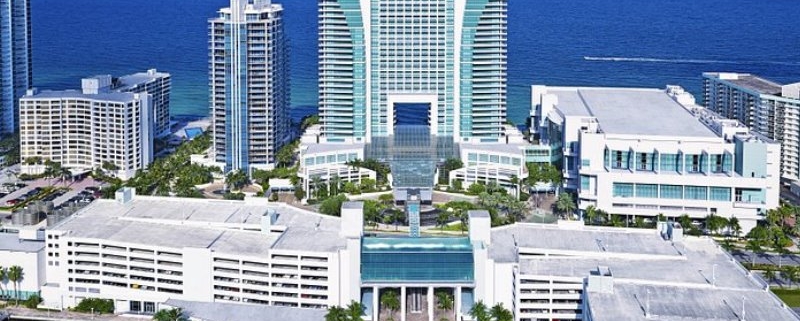It’s been a tremendous start to 2023 for hotel investors who are enjoying record sales for quality assets in highly desirable and growing markets, according to a report from JLL.
The $850 million sale of the Diplomat Beach Resort (pictured above) in Hollywood, Florida, was the third-largest single-asset sale in US history.
The recent closing of the AC Hotel Phoenix Biltmore set a record price-per-key for upscale select-service assets in the Phoenix market.
Kevin Davis, Americas CEO, JLL Hotels & Hospitality Group, said in prepared remarks that investors are buying into the thesis that long-term growth trends in certain markets will outweigh near-term capital markets dislocation.
“As a result, these investors are willing to buy at cap rates that are lower than the cost of debt because the growth story is so compelling.”
The ‘Hottest Asset Class’
Brandon Lewe, vice president of Sales at Ten-X, tells GlobeSt.com that overall, hotels are currently the “hottest” asset class on Ten-X, with momentum building year over year, further highlighting a strong hotel sales outlook.
“Buyers love the category,” Lewe said. “Last year hotels had the highest trade rate (62%) of any asset class and this year, even more investors want to buy.”
Hotel properties had twice the number of bidders per property as the next most popular asset class, he said. “And the trade rate has climbed 10 percentage points – to 72% – for properties that have gone to auction this year.
“We see more inventory coming online and that inventory is high quality, coming from institutional investors. Two of the largest U.S. institutional investors are bringing an influx of new inventory to our platform. ‘SMILE’ states, especially Texas, are hot locations for sellers.”
Extended Stay Cap Rates Approaching Multifamily
Matt McElhare, senior director, Extended Stay Brands at Choice Hotels International, tells GlobeSt.com that generally, “everyone is looking to add exposure to the segment given industry performance and profitability relative to traditional hotels.”
Extended stay at a lower price point provides a different return and risk profile than a traditional hotel or upscale hotel.
“We’ve seen cap rates approaching multifamily levels of the last two years,” McElhare said.
“The demand picture (2x supply, emerging trends providing tailwinds e.g. relocations, reshoring of supply chains, infrastructure, etc.) is really strong, which, combined with the difficulty adding supply in the near/medium term due to higher cost of capital and construction costs, is creating a favorable picture for high performance continuing in the extended stay segment.”
He said the performance outlook is bolstering demand for the acquisition of existing extended-stay hotels despite low cap rates and high valuations, particularly in areas of growth such as the Carolinas, Florida, and Texas.
“Lenders have historically treated hospitality financing as one big bucket but we’re seeing encouraging changes there as lenders recognize the different risk/return profile and think about the segment differently,” McElhare said.
McElhare tells GlobeSt.com that activity for large institutional capital in the space has remained elevated despite the higher costs of capital and construction hard costs as well as evaluations for existing extended-stay product.
Higher Occupancy Means Hiring Challenges
The American Hotel & Lodging Association (AHLA) and Oxford Economics recently reported that it expects hotel-generated state and local tax revenue to set a record at $46.71 billion this year.
Additionally, it sees average U.S. hotel occupancy reaching 63.8% in 2023 – just shy of 2019’s level of 65.9%.
“Staffing is expected to remain a challenge for many U.S. hotels in 2023, as the industry continues to grow its workforce back to pre-pandemic levels,” AHLA said in a release.
Nearly 100,000 hotel jobs are currently open across the nation as of Q4 2022, according to Indeed, even as “national average hotel wages were at historic highs of over $23/hour and hotel benefits and flexibility are better than ever,” according to AHLA.
Source: GlobeSt.



